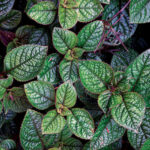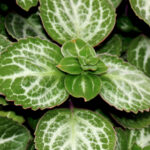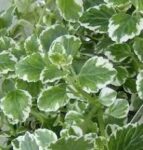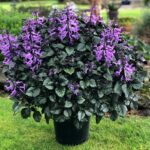How To Care For A Swedish Ivy
Almost
A Swedish Ivy, Plectranthus australis, did not originate in Sweden, nor is it a type of ivy found. Information technology did, all the same, originally go popular as a houseplant in Sweden, and these practise take long cascading stems like a regular ivy plant. Swedish Ivies are part of the Plectranthus genus, and a member of the Lamiaceae family. Information technology is a close relative of the mint plant. Other names for a Swedish Ivy are "Creeping Charlie" and "Swedish Begonia." This like shooting fish in a barrel-care houseplant, native to Southward Africa, can also exist grown as a hardy, perennial, outdoor plant in areas where the temperature stays above 50°F.
Description of Swedish Ivy
Swedish Ivies are lush, virtually succulent – like plants with long, trailing, thick stems. The 1"-i.five" leaves are rounded with scalloped edges. The thick, vivid green leaves are shaped more like a coleus leafage than an ivy foliage. When given enough bright light, a Swedish Ivy produces delicate, white, lavender, or imperial tubular-shaped flowers throughout the yr. Some varieties fifty-fifty take a special smell when touched.
Swedish Ivy Varieties
White-Edged Swedish Ivy (Plectranthus coleoides "variegatea") has dark green leaves with white scalloped edges, and grows about 10"-12" tall and 15"-xx" wide.
Imperial Swedish Ivy (Plectranthus Purpuratus) when placed in brilliant light, has deeply veined, richly colored light-green majestic leaves with purple undersides and tall stalks of small flowers in white, pink, purple, and bluish royal.
Emerald Lace Swedish Ivy (Plectranthus oertendahlii) is a compact plant that has green leaves with silver-colored veins and scalloped edges. The underside of the leaf is purple, and the small flowers are lilac in colour.
Plectranthus "Mona Lavender" Swedish Ivy (Plectranthus ecklonii ) has ii" dark dark-green leaves with purple undersides. It produces long spikes of showy lavender blossoms from fall into spring.
Vick'due south Constitute (Plectranthus tomentosus) is usually known as a "Vicks Found" because the small, dark light-green, fuzzy, velvety leaves smell like Vick's Vap-O-Rub when rubbed. The showy flowers are usually mauve, purple, or white.




Imperial Swedish Ivy "Emerald Lace" White edged"Variegated" Swedish Ivy Flowers
Quick Care Tips for a Swedish Ivy
Wait until leaves get a little soft and flexible earlier watering
Bright indirect light but no straight sunday
Easily propagated using stem tip cuttings in spring or summer
Employ a fertilizer high in nitrogen
Conclusion
A Swedish Ivy makes a wonderful houseplant, growing quickly fifty-fifty for new constitute enthusiasts. It'due south best displayed in a hanging basket where its long vines, sometimes 2-3ft in length and covered in colorful tubular flowers, can be enjoyed. This is a not-toxic found and safe to have around pocket-size children, dogs, cats, and other pets.
Establish Care
Calorie-free
A Swedish Ivy requires bright indirect low-cal, merely no direct sun. Inadequate light causes a Swedish Ivy to "reach' for the light and get leggy.
Water
Allow the top 30% of the soil to dry out out before watering a Swedish Ivy. The easiest way to impale a Swedish Ivy is by over-watering and causing root rot. Yellow leaves indicate the plant is over-watered. The leaves become soft and tiresome greenish when a Swedish Ivy needs water.
Fertilizer
Fertilize a Swedish Ivy every ii weeks in the spring and summer when the plant is actively producing new leaves. Use a found nutrient high in nitrogen, diluted to one/2 the recommended strength.
Temperature
Provide temperatures between 70°-75°F (21.1°-23.ix°C) almost of the year for a Swedish Ivy. During the winter, when the found is not actively growing, cooler temperatures of 60°-65°F (xv.6°-23.9°C) are best.
Humidity
Although a Swedish Ivy prefers high humidity, it still grows chop-chop in regular household humidity.
Flowering
In ideal growing conditions, a Swedish Ivy produces small-scale royal, lavender, pink, or white tubular flowers during the spring and summer.
Pests
Aphids, whitefly, scale, and peculiarly mealy bugs can infest a Swedish Ivy. You tin can run into a picture of these plant pests and read how to place and treat them, in the Glossary of the website.
Diseases
Leaf Spot is the about common plant affliction that infects a Swedish Ivy. Learn how to identify and care for leaf spot disease in the Glossary of the website.
Soil
A Swedish Ivy grows well in an organic, peat moss- based soil that drains well.
Pot Size
Do not rush to move a Swedish Ivy to a larger container. Wait until the roots have filled the current pot and so move the plant to the next size pot and nothing larger. Be certain there are drip holes in the lesser so backlog h2o tin can escape.
Pruning
A Swedish Ivy needs constant pruning to keep it looking full and bushy. Trim several inches off the long vines to encourage new growth. The plant cuttings can be used to propagate new plants.
Propagation
Employ stem cuttings to hands propagate a Swedish Ivy. Read more virtually propagation techniques and exactly how to do it in the Glossary of the website.
Poisonous Plant Info
A Swedish Ivy is a non-poisonous plant.
FAQ
Why Do Swedish Ivies Get Sparse and Gangling Looking?
The primary reason Swedish Ivy indoor plants go thin and gangling is non enough light. Prune the tips of the stems of your Swedish Ivy, move information technology to brighter lite, and watch how bushy it becomes.
Should I Keep the Flowers on My Swedish Ivy or Cut Them Off?
I ever cut the flowers off of my Swedish Ivy plants. When the flowers are left on the establish, it slows down leafage production.
Why Are the Leaves on My Swedish Ivy Soft and Droopy?
The leaves on a Swedish Ivy are commonly soft and droopy when the found needs more water. Another reason could be that the plant is in a location that is too hot. If the soil is damp and the room not as well hot, you may accept over-watered your Swedish Ivy and caused root rot. In that example, have some leafage tip cuttings and propagate a new found before the one-time one dies.
Source: https://www.houseplant411.com/houseplant/swedish-ivy-plant-how-to-grow-care-guide/

0 Response to "How To Care For A Swedish Ivy"
Post a Comment